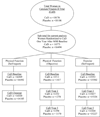Calcium, vitamin D supplementation, and physical function in the Women's Health Initiative
- PMID: 18755319
- PMCID: PMC3875323
- DOI: 10.1016/j.jada.2008.06.432
Calcium, vitamin D supplementation, and physical function in the Women's Health Initiative
Abstract
Objectives: The Women's Health Initiative (WHI) randomized trial of calcium/vitamin D supplementation found reduced bone loss with active treatment compared to placebo. Now we examine whether the treatment affected self-reported physical functioning and objective measures of physical functioning.
Design: A randomized, double-blind, placebo-controlled trial of 1,000 mg calcium carbonate plus 400 IU vitamin D(3) per day or matching placebo pills.
Subjects/setting: The study included 33,067 women (50 to 79 years old) at 40 US study centers.
Main outcome measures: Physical functioning was assessed by questionnaire at enrollment in WHI, 1 year prior to calcium/vitamin D trial randomization and at study close-out (average follow-up 7.1 years). Objective physical performance and self-reported exercise measures were collected at WHI baseline (1 year prior to calcium/vitamin D enrollment) and 2 years and 4 years after calcium/vitamin D trial enrollment in a subsample (n=3,137).
Statistical analyses performed: Calcium/vitamin D effects were tested in unadjusted and interaction linear models for each of the physical function measures. Covariates were baseline total calcium intake, fracture risk score, treatment arm in the hormone therapy and dietary modification trials (ie, active drug or placebo, low-fat diet intervention or usual diet, respectively) and age.
Results: Neither intention to treat nor high adherence analyses produced substantial effects of calcium/vitamin D compared to placebo on physical functioning or performance. The interaction analyses also did not result in differences because of calcium/vitamin D.
Conclusions: As the first long-term randomized trial to examine the effectiveness of calcium and vitamin D in protecting against decline of physical functioning in older women, the results did not support benefit.
Figures
References
-
- Day JC. U.S. Bureau of the Census, Current Population Reports, P25-1130. U.S. Washington, DC: Government Printing Office; 1996. Population projections of the United States by age, sex race and Hispanic origin: 1995 to 2050.
-
- Fried LP, Tangen CM, Walston J, Newman AB, Hirsch C, Gottdiener J, Seeman T, Tracy R, Kop WJ, Burke G, McBurnie MA. Cardiovascular Health Study Collaborative Research Group. Frailty in older adults: evidence for a phenotype. J Gerontol A Biol Sci Med Sci. 2001;56:46–56. - PubMed
-
- Keller HH. Nutrition and health-related quality of life in frail older adults. J Nutr Health Aging. 2004;8:245–252. - PubMed
-
- Houston DK, Stevens J, Cai J, Haines PS. Dairy, fruit, and vegetable intakes and functional limitations and disability in a biracial cohort: the Atherosclerosis risk in Communities Study. Am J Clin Nutr. 2005;81:515–522. - PubMed
-
- Jackson RD, LaCroix AZ, Gass M, Wallace RB, Robbins J, Lewis CE, Bassford T, Beresford SAA, Black HR, Blanchette P, Bonds DE, Brunner RL, Brzyski RG, Caan B, Cauley JA, Chlebowski RT, Cummings SR, Granek I, Hays J, Heiss G, Hendrix SL, Barbara V, Howard BV, Hsia J, Hubbell FA, Johnson KC, Judd H, Kotchen JM, Kuller LH, Langer RD, Lasser NL, Limacher MC, Ludlam S, Manson JE, Margolis KL, McGowan J, Ockene JK, O’Sullivan MJ, Phillips L, Prentice RL, Sarto GE, Stefanick ML, Van Horn L, Wactawski-Wende J, Whitlock E, Anderson GL, Assaf AR, Barad D. Calcium plus vitamin D supplementation and the risk of fractures. NEJM. 2006;354:669–683. - PubMed
Publication types
MeSH terms
Substances
Grants and funding
LinkOut - more resources
Full Text Sources
Medical
Research Materials


